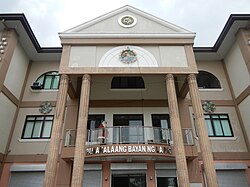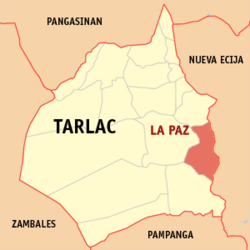La Paz, Tarlac
Municipality in Tarlac, Philippines From Wikipedia, the free encyclopedia
Municipality in Tarlac, Philippines From Wikipedia, the free encyclopedia
La Paz, officially the Municipality of La Paz (Kapampangan: Balen ning La Paz; Ilocano: Ili ti La Paz, Tagalog: Bayan ng La Paz), is a 2nd class municipality in the province of Tarlac, Philippines. According to the 2020 census, it has a population of 68,952 people.[3]
La Paz | |
|---|---|
| Municipality of La Paz | |
 Municipal Hall | |
 Map of Tarlac with La Paz highlighted | |
Location within the Philippines | |
| Coordinates: 15°26′35″N 120°43′44″E | |
| Country | Philippines |
| Region | Central Luzon |
| Province | Tarlac |
| District | 3rd district |
| Founded | January 24, 1892 |
| Barangays | 21 (see Barangays) |
| Government | |
| • Type | Sangguniang Bayan |
| • Mayor | Venustiano D. Jordan |
| • Vice Mayor | Lorna R. Manalo |
| • Representative | Noel L. Villanueva |
| • Electorate | 43,885 voters (2022) |
| Area | |
| • Total | 114.33 km2 (44.14 sq mi) |
| Elevation | 21 m (69 ft) |
| Highest elevation | 35 m (115 ft) |
| Lowest elevation | 14 m (46 ft) |
| Population (2020 census)[3] | |
| • Total | 68,952 |
| • Density | 600/km2 (1,600/sq mi) |
| • Households | 16,031 |
| Economy | |
| • Income class | 2nd municipal income class |
| • Poverty incidence | 15.08 |
| • Revenue | ₱ 202.4 million (2020) |
| • Assets | ₱ 475.2 million (2020) |
| • Expenditure | ₱ 179.4 million (2020) |
| • Liabilities | ₱ 193.3 million (2020) |
| Service provider | |
| • Electricity | Tarlac 2 Electric Cooperative (TARELCO 2) |
| Time zone | UTC+8 (PST) |
| ZIP code | 2314 |
| PSGC | |
| IDD : area code | +63 (0)45 |
| Native languages | Kapampangan Tagalog Ilocano |
The early history of La Paz needs to be clarified. Legends state that an old pueblo called "Cama Juan" was situated along the bank of the Chico River, bordering the province of Tarlac and Nueva Ecija. When the Chico River overflowed during a storm, a great flood swept the entire pueblo during the night. The flood is said to have devastated the area, claiming many lives.[5]
This forced the inhabitants of "Cama Juan" to evacuate. The old site (Cama Juan) is known as "Balen Melakwan" or "Abandoned Town".
The inhabitants chose a field of evergreen grass and shrubbery on which to rebuild, which they named "Matayumtayum".[5]
Towards the end of the nineteenth century, Francisco Macabulos and Captain Mariano Ignacio selected a more centrally located site for the future town to be known as La Paz. This existed only as a barrio of the town of Tarlac until 1892, when it was separated from the latter and rechristened in honor of its patron saint Nuestra Senora de La Paz y Buen Viaje. Its emergence as a new town gave its citizens a chance to run their own government with Martin Aquino as the first Governadorcillo.[5]
La Paz was made the first seat of the revolutionary government of the province of Tarlac during the Spanish regime with Gen. Francisco Makabulos as its first provincial governor.
La Paz lies in the southeast portion of the province and is 141 kilometres (88 mi) from Metro Manila, 17 kilometres (11 mi) from the provincial capital of Tarlac City, and 33 kilometres (21 mi) from Cabanatuan. It is bounded on the north by the town of Victoria, on the east by the Province of Nueva Ecija, on the south by the town of Concepcion and on the west by Tarlac City.
The municipality has a total land area of 11,433 hectares (28,250 acres) which represents 2.34% of the entire provincial area. La Paz is politically subdivided into 18 barangays, of which barangays San Isidro and San Roque are considered as urban areas and the rest of the barangays are considered rural areas.
La Paz is politically subdivided into 21 barangays: [6] Each barangay consists of puroks and some have sitios.
| Climate data for La Paz, Tarlac | |||||||||||||
|---|---|---|---|---|---|---|---|---|---|---|---|---|---|
| Month | Jan | Feb | Mar | Apr | May | Jun | Jul | Aug | Sep | Oct | Nov | Dec | Year |
| Mean daily maximum °C (°F) | 28 (82) |
30 (86) |
31 (88) |
33 (91) |
33 (91) |
31 (88) |
30 (86) |
29 (84) |
29 (84) |
30 (86) |
30 (86) |
29 (84) |
30 (86) |
| Mean daily minimum °C (°F) | 10 (50) |
20 (68) |
20 (68) |
22 (72) |
24 (75) |
24 (75) |
24 (75) |
24 (75) |
24 (75) |
23 (73) |
22 (72) |
21 (70) |
22 (71) |
| Average precipitation mm (inches) | 4 (0.2) |
4 (0.2) |
5 (0.2) |
11 (0.4) |
66 (2.6) |
99 (3.9) |
127 (5.0) |
113 (4.4) |
99 (3.9) |
84 (3.3) |
35 (1.4) |
14 (0.6) |
661 (26.1) |
| Average rainy days | 2.2 | 1.9 | 3.2 | 5.3 | 16.1 | 20.8 | 23.5 | 22.8 | 22.2 | 16.5 | 8.9 | 3.5 | 146.9 |
| Source: Meteoblue[7] | |||||||||||||
| Year | Pop. | ±% p.a. |
|---|---|---|
| 1903 | 4,389 | — |
| 1918 | 8,991 | +4.90% |
| 1939 | 13,298 | +1.88% |
| 1948 | 18,395 | +3.67% |
| 1960 | 21,843 | +1.44% |
| 1970 | 27,150 | +2.20% |
| 1975 | 32,885 | +3.92% |
| 1980 | 35,330 | +1.44% |
| 1990 | 41,946 | +1.73% |
| 1995 | 45,207 | +1.41% |
| 2000 | 52,907 | +3.43% |
| 2007 | 61,324 | +2.06% |
| 2010 | 60,982 | −0.20% |
| 2015 | 64,017 | +0.93% |
| 2020 | 68,952 | +1.47% |
| Source: Philippine Statistics Authority[8][9][10][11] | ||
In the 2020 census, the population of La Paz, Tarlac, was 68,952 people,[3] with a density of 600 inhabitants per square kilometre or 1,600 inhabitants per square mile.
Poverty incidence of La Paz
5
10
15
20
25
30
2006
21.20 2009
17.02 2012
6.43 2015
16.61 2018
10.37 2021
15.08 Source: Philippine Statistics Authority[12][13][14][15][16][17][18][19] |

The feast of Nuestra De Seṅora De La Paz every January 23 to 24. Other tourism attractions in the town include Macabulos ancestral house, Nuestra Seṅora De La Paz Church, and Chico River Grill Station.
The municipality has an approximate total road network of 78.863 kilometres (49.003 mi) which are classified into four (4) categories, namely: national, provincial, municipal and barangay roads.
The barangay road network has an approximate length of 49.264 kilometres (30.611 mi). The roads are paved with either concrete, asphalt, gravel or dirt. The gravel and dirt roads have a total length of 42.794 kilometres (26.591 mi).
La Paz is the northern terminus of the Subic–Clark–Tarlac Expressway (SCTEx) where it connects with Tarlac–Pangasinan–La Union Expressway (TPLEx) and Central Luzon Link Expressway (CLLEx).
Several buses from Metro Manila going Nueva Ecija passes through the town via Subic–Clark–Tarlac Expressway (SCTEx).
Seamless Wikipedia browsing. On steroids.
Every time you click a link to Wikipedia, Wiktionary or Wikiquote in your browser's search results, it will show the modern Wikiwand interface.
Wikiwand extension is a five stars, simple, with minimum permission required to keep your browsing private, safe and transparent.